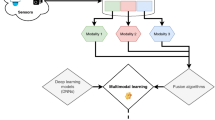Abstract
Deep transfer learning emerged as a new paradigm in machine learning in which a deep model is trained on a source task and the knowledge acquired is then totally or partially transferred to help in solving a target task. In this paper, we apply the source–target–source methodology, both in its original form and an extended multi-source version, to the problem of cross-sensor biometric recognition. We tested the proposed methodology on the publicly available CSIP image database, achieving state-of-the-art results in a wide variety of cross-sensor scenarios.







Similar content being viewed by others
References
Dai W, Xue GR, Yang Q, Yu Y (2007) Co-clustering based classification for out-of-domain documents. In: Proceedings of the 13th ACM SIGKDD international conference on Knowledge discovery and data mining. ACM, pp 210–219
Yang J, Yan R, Hauptmann AG (2007) Cross-domain video concept detection using adaptive svms. In: Proceedings of the 15th international conference on Multimedia. ACM, pp 188–197
Blitzer J, Dredze M, Pereira F et al (2007) Biographies, bollywood, boom-boxes and blenders: domain adaptation for sentiment classification. ACL 7:440–447
Dahlmeier D, Ng HT (2010) Domain adaptation for semantic role labeling in the biomedical domain. Bioinformatics 26(8):1098–1104
Pan SJ, Shen D, Yang Q, Kwok JT (2008) Transferring localization models across space. In: AAAI, pp 1383–1388
Kandaswamy C, Silva LM, Cardoso JS (2015) Source-target-source classification using stacked denoising autoencoders. In: Pattern recognition and image analysis. Springer, pp 39–47
Caruana R (1997) Multitask learning. Mach Learn 28(1):41–75
Thrun S (1998) Lifelong learning algorithms. In: Learning to learn. Springer, pp 181–209
Daume III H, Marcu D (2006) Domain adaptation for statistical classifiers. J Artif Intell Res 26:101–126
Glorot X, Bordes A, Bengio Y (2011) Domain adaptation for large-scale sentiment classification: a deep learning approach. In Proceedings of the 28th international conference on machine learning (ICML-11), pp 513–520
Ben-David S, Blitzer J, Crammer K, Kulesza A, Pereira F, Vaughan JW (2010) A theory of learning from different domains. Mach Learn 79(1–2):151–175
Bruzzone L, Marconcini M (2010) Domain adaptation problems: a DASVM classification technique and a circular validation strategy. IEEE Trans Pattern Anal Mach Intell 32(5):770–787
Ciresan D, Meier U, Schmidhuber J (2012) Multi-column deep neural networks for image classification. In: 2012 IEEE conference on computer vision and pattern recognition (CVPR). IEEE, pp 3642–3649
Yosinski J, Clune J, Bengio Y, Lipson H (2014) How transferable are features in deep neural networks? In: Advances in neural information processing systems, pp 3320–3328
Kandaswamy C, Silva LM, Alexandre LA, Santos JM, de Sá JM (2014) Improving deep neural network performance by reusing features trained with transductive transference. In: Artificial neural networks and machine learning—ICANN 2014. Springer, pp 265–272
Bengio Y, Courville A, Vincent P (2013) Representation learning: a review and new perspectives. IEEE Trans Pattern Anal Mach Intell 35(8):1798–1828
Connaughton R, Sgroi A, Bowyer KW, Flynn P (2011) A cross-sensor evaluation of three commercial iris cameras for iris biometrics. In: IEEE computer society conference on computer vision and pattern recognition workshops (CVPRW). IEEE, pp 90–97
Monteiro JC, Esteves R, Santos G, Fiadeiro PT, Lobo J, Cardoso JS (2015) A comparative analysis of two approaches to periocular recognition in mobile scenarios. In: Advances in visual computing, vol. 9475 of Lecture Notes in Computer Science. Springer International Publishing, pp 268–280
Pillai J, Puertas M, Chellappa R (2014) Cross-sensor iris recognition through Kernel learning. IEEE Trans Pattern Anal Mach Intell 36:73–85
Santos G, Grancho E, Bernardo MV, Fiadeiro PT (2015) Fusing iris and periocular information for cross-sensor recognition. Pattern Recogn Lett 57:52–59
Jillela R, Ross A (2014) Matching face against iris images using periocular information. In: 2014 IEEE international conference on image processing (ICIP). IEEE, pp 4997–5001
Woodard DL, Pundlik S, Miller P, Jillela R, Ross A (2010) On the fusion of periocular and iris biometrics in non-ideal imagery. In: 2010 20th international conference on pattern recognition (ICPR). IEEE, pp 201–204
Shao L, Zhu F, Li X (2015) Transfer learning for visual categorization: a survey. IEEE Trans Neutral Netw Learn Syst 26(5):1019–1034
Monteiro JC, Cardoso JS (2015) Periocular recognition under unconstrained settings with universal background models. In: Proceedings of the international conference on bio-inspired systems and signal processing (BIOSIGNALS)
Reynolds DA, Quatieri TF, Dunn RB (2000) Speaker verification using adapted Gaussian mixture models. Digit Signal Process 10(1):19–41
JCM et al (2015) Periocular recognition in mobile scenarios: a comparative analysis of two approaches. In: Proceedings of 11th international symposium on visual computing (ISVC)
Campbell WM, Sturim DE, Reynolds DA (2006) Support vector machines using gmm supervectors for speaker verification. IEEE Signal Process Lett 13(5):308–311
Ge Z, McCool C, Sanderson C, Corke P (2015) Modelling local deep convolutional neural network features to improve fine-grained image classification. arXiv preprint arXiv:1502.07802
Kandaswamy C, Silva LM, Alexandre L, Sousa R, Santos JM, de Sá JM et al (2014) Improving transfer learning accuracy by reusing stacked denoising autoencoders. In: 2014 IEEE international conference on systems, man and cybernetics (SMC). IEEE, pp 1380–1387
Tan T, He Z, Sun Z (2010) Efficient and robust segmentation of noisy iris images for non-cooperative iris recognition. Image Vis Comput 28(2):223–230
Proença H, Alexandre L (2007) The NICE. I: noisy iris challenge evaluation—part I. In: First IEEE international conference on biometrics: theory, applications, and systems. IEEE, pp 1–4
Acknowledgments
This work was financed by FEDER funds through the Programa Operacional Factores de Competitividade—COMPETE and by Portuguese funds through FCT—Fundação para a Ciência e Tecnologia in the framework of the project PTDC/EIA-EIA/119004/2010. The second author would like to thank Fundação para a Ciência e Tecnologia (FCT)—Portugal the financial support for the PhD grant SFRH/BD/87392/2012.
Author information
Authors and Affiliations
Corresponding author
Rights and permissions
About this article
Cite this article
Kandaswamy, C., Monteiro, J.C., Silva, L.M. et al. Multi-source deep transfer learning for cross-sensor biometrics. Neural Comput & Applic 28, 2461–2475 (2017). https://doi.org/10.1007/s00521-016-2325-5
Received:
Accepted:
Published:
Issue Date:
DOI: https://doi.org/10.1007/s00521-016-2325-5




